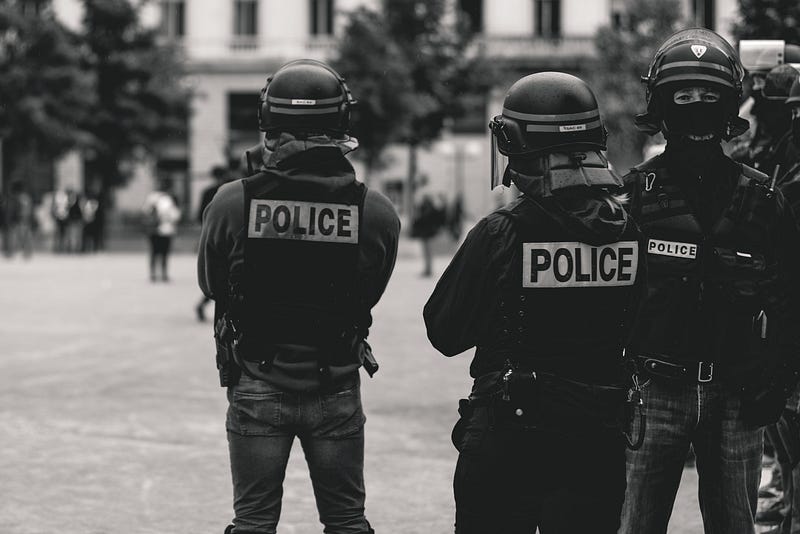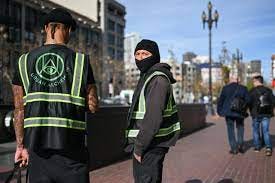Strong communities protect us better than armed militias.

Just three months after San Francisco District Attorney Chesa Boudin was recalled for being “soft on crime,” local media and police advocates are screaming louder than ever about crime in the city. News stories about crime run every day. If they can’t find some locally, they report scare stories from elsewhere.
Regular people are, in fact, scared. All over the country, threads on Nextdoor.com are filled with complaints about crime and fear of crime, ‘Watch out for this guy across the street,’ ‘The police never come when you call’ and things like that. People feel less safe, and authoritarians use that fear to push for increases in police budgets and repression of people seen as dangerous, whether or not they pose a real threat.
This dynamic has been normal in over-policed African-American communities for decades, but now all kinds of people are affected. Why are people afraid, and what can we do about it? Can police protect us from the effects of poverty, homelessness, mental illness and addiction, climate chaos, and social disintegration? Although some studies show slight crime reductions with more police, lots of studies show they can’t help. I argue here that building stronger communities is the best way to feel safe and to actually be safe..
Why people live in fear
Life is getting harder. Prices go up, wages stay low, people don’t have jobs or places to live, so some turn to crime. As with chronic health problems like diabetes, society has the disease. Individuals (whether diabetics, criminals, or victims) just get the symptoms. People have a right to fear crime, but for many, crime is just one out of a raft of potential disasters.
I see how fear of crime affects people in my own neighborhood. A 3200 unit rental development in San Francisco, it has been lower-middle class since its construction in the 40s and 50s. When I came here in 1998, my neighbors were teachers, nurses, plumbers, retirees, and young families just starting out. It was uninteresting but attractive and safe.
Times have changed since then. The kinds of people who used to live here cannot afford the rent; though it’s below San Francisco averages. Many units are now filled by people on housing assistance (Section 8) or by squatters who don’t pay rent at all. One staff rep told me there are too many vacancies for them to keep on top of, so squatters move in, stay until thrown out, then come back a few days later.
Of course, most people don’t really care if their neighbors are paying rent or not, but a lot of these squatters supplement their income by robbing packages, breaking into cars, even robbing stores in the local strip mall at night.
Some people are understandably uncomfortable with these changes, which are the same problems the whole city and many other cities are dealing with. The forms differ because the environments differ. We don’t have people living in tents outside our doors. There’s not much street crime yet, but it’s gotten so Amazon Prime shouldn’t even bother delivering packages. They don’t get to the customers anyway.
To me, these feel like minor problems, but they have an impact. If the complex gets a bad reputation and occupancy rate drops too low, owners will cut back on services, buildings will deteriorate, and our homes will sink into a downward spiral.
So, what can we do? Management has an answer: call the police. A lot of residents do that; it’s natural to trust authority. But it doesn’t work.
Why police can’t help
While having more officers on the street probably reduces crime in their immediate vicinity, data shows police have very little effect on overall crime. The problem is that crime and violence don’t come out of nowhere. There are deeper causes that must be addressed, and police aren’t equipped to address them. Locking up offenders to stop crime is like cutting the top off an encroaching kudzu plant and expecting the kudzu to go away.
The Marshall Project, a justice reform think tank wrote, “Since the 1970s, rollbacks in the social safety net, growing income inequality and de-institutionalization of the mentally ill have meant that police officers are tasked with responding to an ever-growing list of social problems. At the same time, lawmakers have chosen to criminalize and prosecute nonviolent misdemeanors like sleeping on the sidewalk and disorderly conduct.” Police are not the right ones to address such issues. Community organizations are.
Instead of building communities, though, governments at every level rely on police to maintain order. A thorough study from 2012 in the Center for American Progress found that, “As the size and budgets of American police forces grew, so too did their role in the community. Efforts to address underlying community problems through social investment took a backseat [to] policing strategies. As a result, American police officers make more than 10 million arrests each year, less than 5 percent of which are for serious violent crimes.”
More recently, a large study by the Brookings Institution detailed how policing had very limited effects on antisocial behavior and called for a “Public Health approach” to crime.
Their recommendations included providing people with medical care including mental health and substance abuse treatment. Cities such as Eugene OR and Denver CO successfully use non-police community responders to deal with mental health and drug related problems.
Some of this intervention is done by professionals, and some by neighborhood-or-street-level “violence interrupters” or “neighborhood change agents” who de-escalate conflicts, build relationships, and promote community safety through nonviolent means.” San Francisco has a couple of organizations like that, such as Urban Alchemy, though not in my neighborhood.

The authors report on economic opportunity programs such as jobs, financial assistance, grants to fix up and develop housing, and resulting drops in crime of up to 50%, including in domestic violence.
Other community-based approaches with proven success include youth programs such as job skills training, mentorship, sports, culture, and education. For youth and adults, creating healthier environments helps — “including fixing abandoned buildings, increasing access to parks, improving lighting, creating community gardens and gathering spaces.”
Crime is a symptom; it’s not the disease. A healthier community will have less crime. People are starting to see now that personal wealth won’t enable us to live well in a disintegrating society. That might work in gated communities of millionaires, but in our neighborhood, we need each other. Without substantial support from government or philanthropists, we can’t do all the things the Brookings report recommended. But we can start where we are and build up.
How strong communities can help
We can start by getting to know our neighbors. In my building, we organize monthly social hours, as I described here, and encourage new people to come. Young healthy neighbors can check in on older ones. People leave extra food and clothing in a common space for people to pick up. Many things other than crime — think food and housing insecurity — make people unsafe, and we can address some of them.
Problems such as homelessness and outdoor drug markets might go beyond our abilities to handle by ourselves, but if management and government collaborate with community groups, maybe we could handle them.
In our neighborhood, the low-income tenants moving here under Section 8 need support. Most have never lived in a place like this before; older residents are suspicious of them; they don’t have friends here. We are asking management to provide support for them, somebody of whom to ask questions, arrange meetings with neighbors so people get to know each other. We want to call these consultants ‘community builders.’
As a community, we can defuse conflicts between residents, but violent people can come in from outside, and at some point neighborhoods might need community patrols. At some point if things continue to collapse, they might need to be armed. The Black Panther Party for Self-Defense started as a community patrol and built a whole movement before the government crushed them.
Problems with communities
Strong communities have pluses and minuses. While they give constant support — kids have kids to play with and adults they can trust — they also limit individual freedom, because people are paying attention to each other.
Community is opposed to the dominant narrative of life purpose — increasing wealth and personal development, career, travel, entertainment. There is not much room for place, family or community in that kind of life, so the more successful you are in the dominant paradigm, the less community you will have and the more stressed you might be. The narrative that exalts individuals over community seems like a marketing scam, one that has taken in our whole society.
The dominant narrative of separateness may not cause crime, but it sets us up for crime when times are hard and wealth inequalities reach insane levels as they have now. If you can’t support yourself with work, why not steal? Community takes us out of that narrative. The more involved we become in the places we live and work, the safer we will be.
Conclusion
Crime is up because economic desperation is up and social supports are breaking down. But crime is only one of many dangers people face. More public safety providers could help, but police aren’t the best people for this job. Only by organizing our communities, including talking to people who might break laws out of need or distress, can we be as safe as possible in a world our leaders are making more dangerous every day.
— — — — — — –
Thanks for reading! Please comment, share, or steal. Follow me on Twitter, on Facebook or on Medium.com. Hire me for freelancing, editing, or tutoring on Linked In
